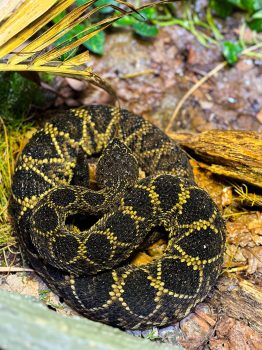Eastern Diamondback Rattlesnake
Common Name: Eastern Diamondback Rattlesnake
Scientific Name: Crotalus adamanteus
Names: Cajun
Locations: Vaughan and Whitby


Diet
Eastern Diamondback Rattlesnakes are carnivorous and primarily feed on small mammals such as rats, mice, rabbits, and squirrels. They are ambush predators, lying in wait for their prey before striking with their venomous bite.
Average lifespan
In the wild, Eastern Diamondback Rattlesnakes typically live around 10 to 20 years.
Size
Eastern Diamondback Rattlesnakes are one of the largest venomous snakes in North America. They can reach lengths of up to 1.8 to 2.4 meters (6 to 8 feet).
Weight
Adult Eastern Diamondback Rattlesnakes can weigh between 2.7 to 6.8 kilograms (6 to 15 pounds).
About
Eastern Diamondback Rattlesnakes are native to the southeastern United States, inhabiting a variety of habitats including pine forests, scrublands, and coastal dunes. They are named for the distinctive diamond-shaped patterns on their dorsal scales and the rattle at the end of their tail, which they use as a warning signal when threatened.
Size and behavior
Eastern Diamondback Rattlesnakes are primarily terrestrial, but they are also capable swimmers. They are solitary and nocturnal hunters, relying on their excellent camouflage to ambush prey. When threatened, they will coil and rattle their tails as a warning signal before striking if necessary.
Diet and nutrition
Eastern Diamondback Rattlesnakes have a carnivorous diet consisting mainly of small mammals. Their venomous bite immobilizes their prey, allowing them to consume it at their leisure. After swallowing their prey whole, they use powerful digestive enzymes to break down and assimilate nutrients from their meal.
Conservation status
Eastern Diamondback Rattlesnakes are currently listed as “Threatened” by the International Union for Conservation of Nature (IUCN). Habitat loss, fragmentation, and persecution by humans are significant threats to their populations. Additionally, they are often killed by humans out of fear or misunderstanding. Conservation efforts focused on habitat preservation, education, and snake-friendly practices are crucial for the long-term survival of Eastern Diamondback Rattlesnakes.
Fun fact
Eastern Diamondback Rattlesnakes have specialized heat-sensing pits located between their nostrils and eyes, which allow them to detect infrared radiation emitted by warm-blooded prey. This unique sensory adaptation helps them locate and strike at prey even in low light conditions or dense vegetation.
Call or visit your local Reptilia Facility to learn how you can adopt one of these amazing reptiles.










